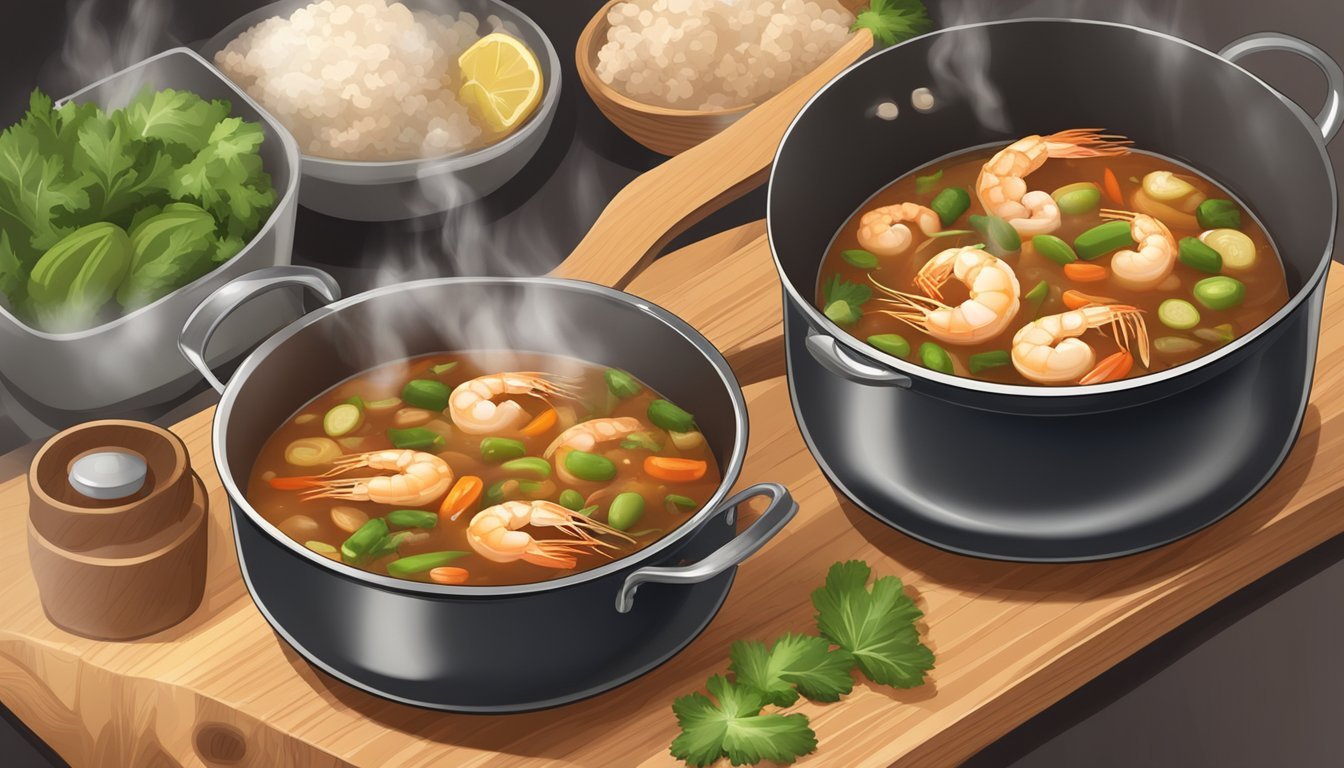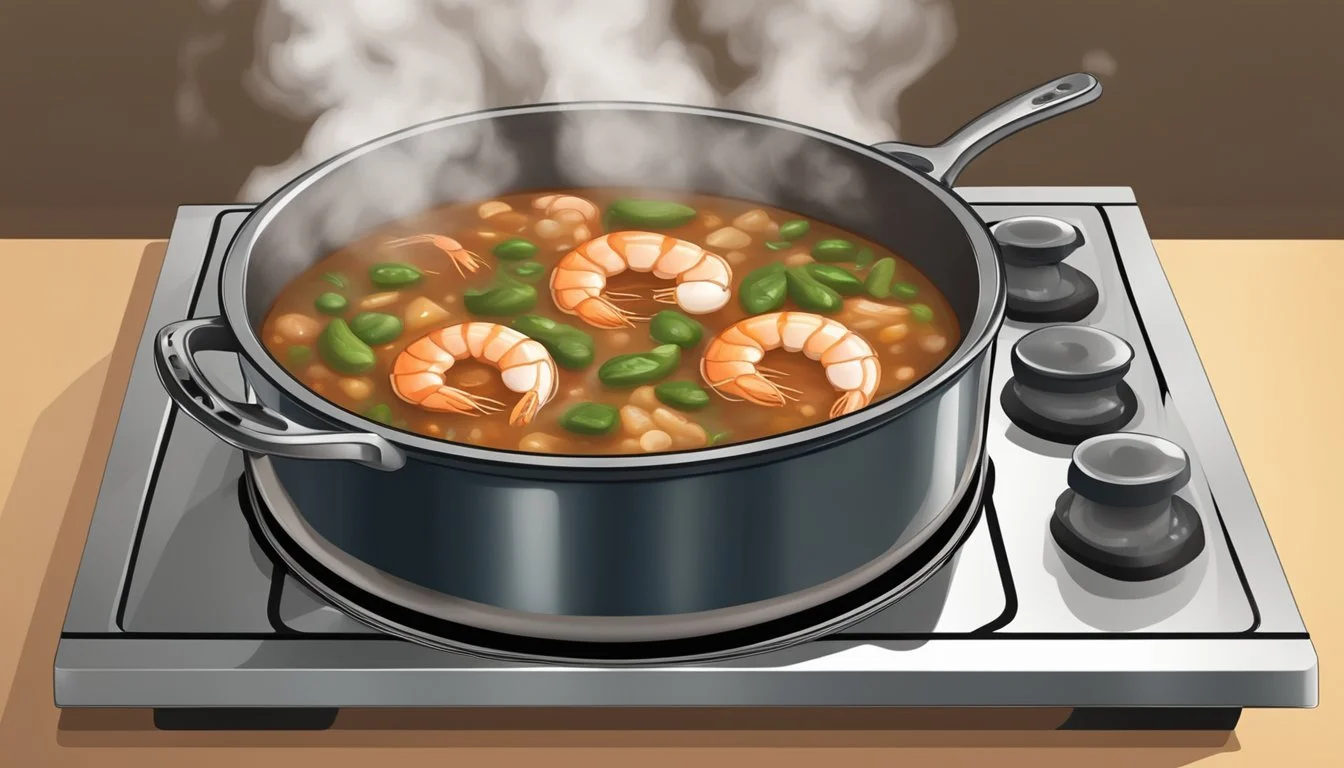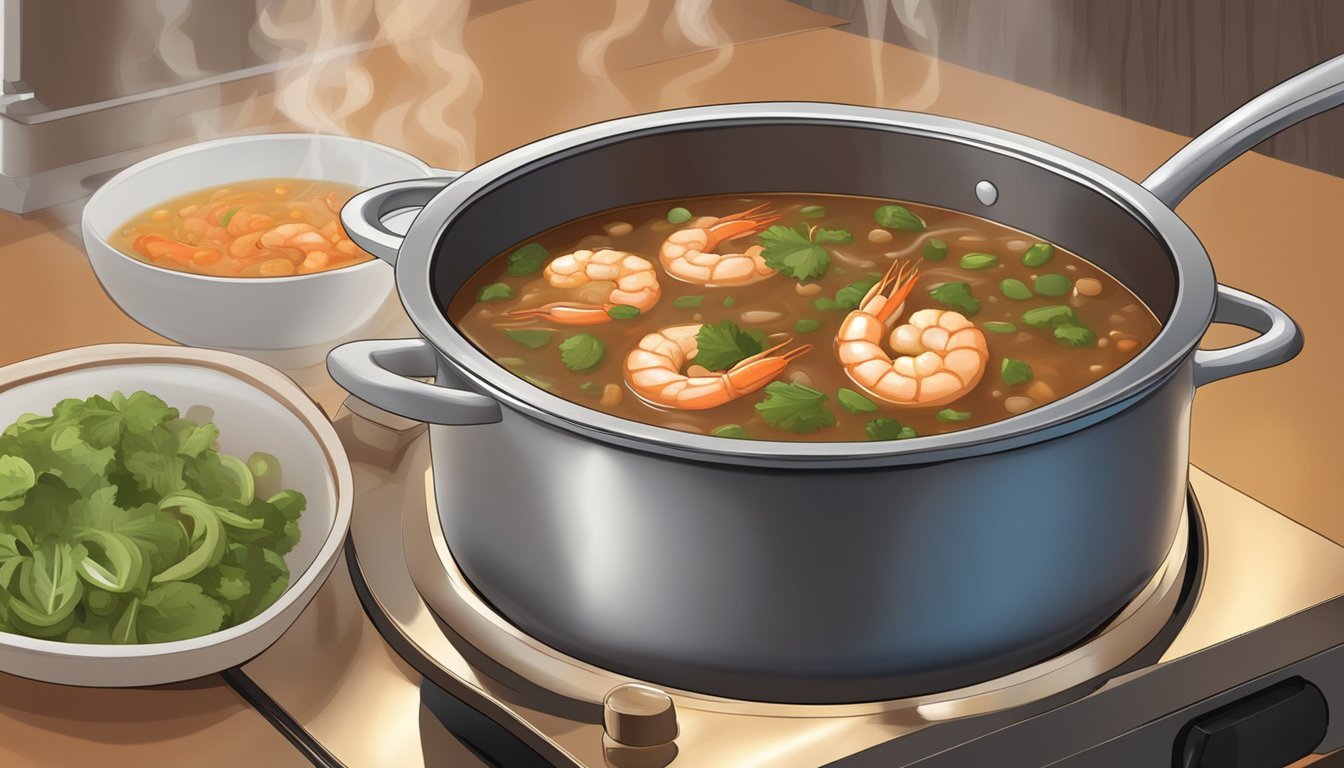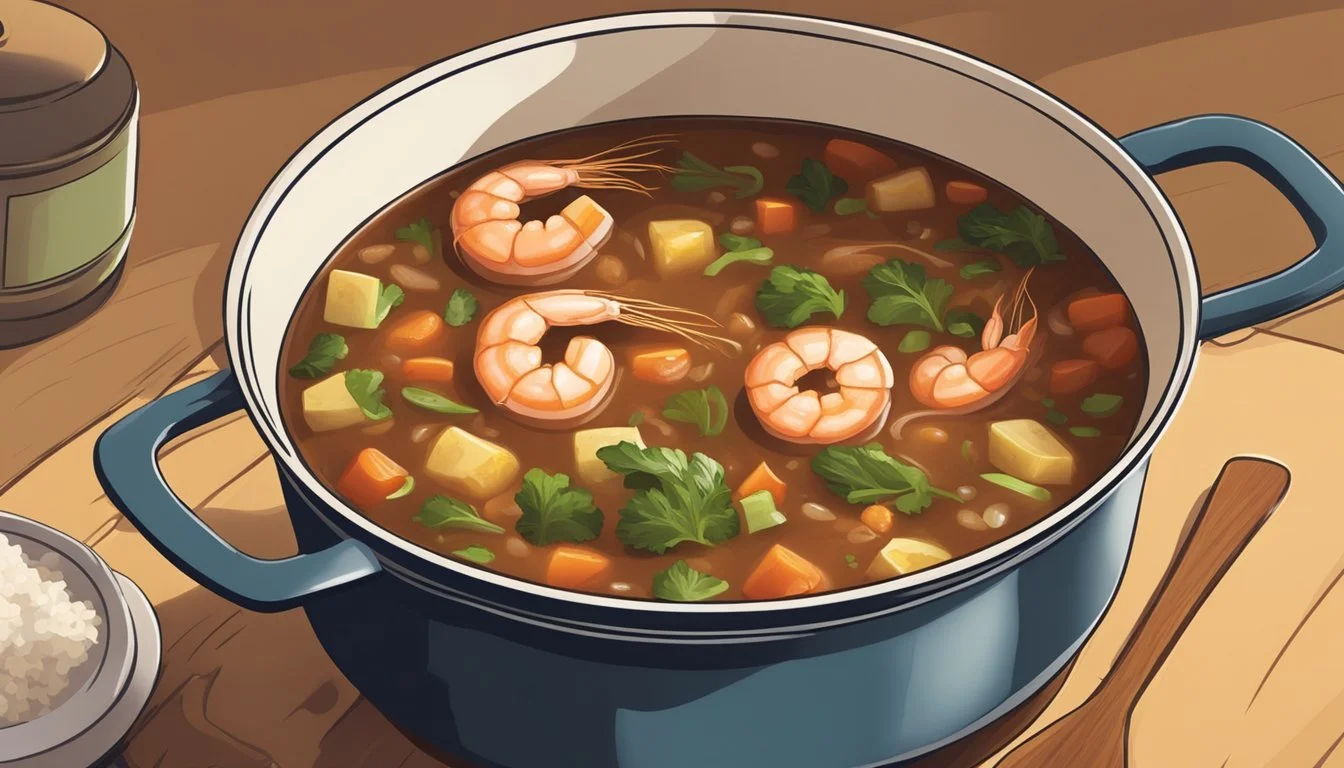Best Way to Reheat Shrimp Gumbo Without Sacrificing Flavor
Tips for Preserving the Spice
Shrimp gumbo is a beloved dish known for its hearty ingredients and flavorful melding of spices. To maintain the integrity of this dish upon reheating, one must approach the process with care to preserve its rich flavors and ensure food safety. Techniques vary depending on the equipment available and the time at one's disposal, but the goal remains the same: to revive the gumbo's original taste and texture without compromising its delicate components, such as the roux and shrimp.
Reheating gumbo requires gentle heat and consistent stirring to distribute warmth evenly and prevent separation of the roux—a mix of flour and fat that is foundational to gumbo's texture and taste. Microwaving may offer a quick solution, though it necessitates cautious timing and protective covering to avoid splatters, while monitoring to ensure the dish reaches the required internal temperature for safety. On the stovetop, a low and slow approach with the addition of a small amount of liquid can reinvigorate the gumbo while safeguarding the roux and keeping the shrimp succulent.
Understanding Gumbo
Gumbo is a culinary staple in Southern cuisine, particularly in Louisiana. It's a hearty dish that encompasses a blend of various ingredients and flavors, each adding to the dish's richness and complexity.
Key Ingredients in Gumbo
Gumbo combines a variety of ingredients, each crucial to creating the authentic taste of the dish. Commonly, shrimp, chicken, and andouille sausage are the main proteins, providing a range of textures and flavors. Vegetables like onion, celery, and green onions form the "holy trinity" base, while okra or filé powder is used to thicken the gumbo. Tomatoes can be added depending on the style of the gumbo. The foundation of the dish is the roux, a cooked mixture of fat and flour, which imparts a deep flavor and silky texture.
Gumbo's Signature Flavor Profile
The dish's distinct taste comes from a blend of spices and herbs. Bay leaves, cayenne pepper, and thyme are staples that give gumbo its signature spicy kick, while Cajun seasoning adds depth and heat. Gumbo is traditionally served over a bed of rice, which balances and absorbs the stew's (What wine goes well with stews?) robust flavors.
The Importance of Proper Storage
Proper storage of gumbo is critical in maintaining its flavor and preventing spoilage. It should be refrigerated within two hours of cooking and can be kept in the refrigerator for up to three days. For longer storage, gumbo can be frozen, but careful consideration must be given to the thawing and reheating process to ensure the dish's integrity.
Pre-Reheating Preparation
Preparing the gumbo correctly before reheating is essential to maintain its rich flavors and avoid any texture issues. Careful thawing and moisture management are key.
Thawing and Bringing Gumbo to Room Temperature
If the gumbo has been stored in the freezer, one should ensure it is thoroughly thawed before attempting to reheat. This can be accomplished by transferring the gumbo from the freezer to the refrigerator, allowing it to thaw overnight gradually. Before reheating, it's advantageous to let the gumbo sit at room temperature for about 20 to 30 minutes. This step helps in even reheating and prevents shocking the roux, which could lead to separation.
Adding Liquid to Preserve Moisture
During the reheating process, gumbo may lose moisture, which can affect its consistency and flavor. To preserve the gumbo's moisture, one can add a small amount of liquid—preferably broth or water—before heating. Here is a suggested method for different reheating techniques:
Microwave: Stir in 1-2 tablespoons of liquid per cup of gumbo.
Oven or Stovetop: Add enough liquid to just cover the bottom of the container or pot, about 1/4 cup, and stir gently to incorporate.
Adding liquid helps maintain the gumbo's stew-like consistency and prevents the ingredients, especially shrimp and other seafood components, from becoming tough.
Reheating Techniques
Proper reheating methods ensure that shrimp gumbo retains its rich flavors and preferred texture. Each technique below highlights how to warm the dish to the ideal serving temperature of 165°F while preserving its quality.
Stovetop Reheating Method
One can reheat shrimp gumbo on the stovetop by placing it in a skillet or pot over a low to medium heat. This method allows for better control over the temperature, ensuring an even heat distribution. To prevent sticking and preserve the roux, one should add a small amount of liquid if necessary and stir regularly.
Oven Reheating Method
The oven method involves preheating the oven to 350°F and transferring the gumbo into an oven-safe container. It should be covered with foil or a lid to lock in moisture. One should then place the container on the middle rack and allow it to heat for about 20-30 minutes. This method is suitable for larger quantities and helps to maintain an even temperature throughout the dish.
Microwave Reheating Method
When using a microwave, the gumbo should be placed in a microwave-safe container, and it's advisable to cover it to avoid splatters. Heating on medium power in one-minute intervals, stirring in between, can prevent overheating. One needs to ensure that the gumbo reaches the internal temperature of at least 165°F before consumption.
Slow Cooker Reheating Method
For a slow and gentle reheating, placing the gumbo in a slow cooker set to a low or warm setting is effective. This process takes longer, often several hours, but can enhance the dish's flavors without any risk of overcooking parts of it. One must occasionally stir the gumbo and add liquid as needed to achieve the desired consistency.
Maintaining Flavor and Texture
Preserving the rich and spicy flavor of shrimp gumbo along with its distinct texture requires careful reheating to avoid overcooking and drying out its component ingredients.
Avoiding Overcooking
Reheating shrimp gumbo should be done gently to ensure that the shrimp remain tender and the roux-based sauce does not separate. Shrimp, prone to becoming rubbery when overcooked, must be heated just enough to reach a safe consumption temperature without compromising their texture. The ideal internal temperature for reheating gumbo is at least 165°F (74°C) to eliminate the risk of bacterial growth.
Reheating Shrimp Properly
To reheat shrimp within gumbo effectively, it is recommended to:
Separate the shrimp from the gumbo if possible, and reheat them briefly and separately.
Use a method that provides even heat distribution, such as reheating in a saucepan over a low flame.
These steps help to maintain the shrimp's tender texture while also ensuring that the gumbo itself does not become overcooked.
Techniques to Avoid Drying Out Ingredients
Maintaining the seafood gumbo's luxurious texture involves retaining moisture throughout the reheating process. To prevent drying out:
Cover the gumbo with a lid or aluminum foil when reheating in the oven at a temperature of 325°F (160°C).
Stirring occasionally can help distribute heat evenly and incorporate moisture back into the ingredients.
By carefully managing temperature and reheating conditions, the gumbo's intrinsic flavor and comforting texture can be preserved.
Food Safety Considerations
When reheating shrimp gumbo, it is imperative to focus on food safety to prevent illness. Ensuring the gumbo is reheated to the right temperature and that there are no signs of spoilage are critical elements in maintaining its quality and safety.
Preventing Bacterial Growth
To inhibit bacterial growth in shrimp gumbo, it's essential to cool it quickly after the initial cooking. Bacteria can multiply rapidly between the temperatures of 40°F and 140°F; therefore, gumbo should not be left out at room temperature for more than two hours. If storing for later use, divide it into shallow containers to speed up the cooling process before refrigeration.
Achieving Safe Internal Temperature
Shrimp gumbo should be reheated to a safe internal temperature of 165°F to eliminate harmful bacteria. Use a food thermometer to check the temperature. Whether reheating in a microwave or on the stove, stir occasionally to help the heat distribute evenly. Microwaving the gumbo in one-minute intervals with stirring in between can help reach the desired temperature throughout the dish without overheating.
Identifying Spoilage Signs
Before reheating, inspect the gumbo for signs of spoilage. Indicators of gumbo that is no longer safe to consume include:
Off odor: A strong, unpleasant smell that differs from the rich, spicy aroma typically associated with gumbo.
Visual changes: The presence of mold or an unexpected change in the color of the gumbo.
Texture changes: A slimy or excessively thick consistency can signify spoilage. If any signs of spoilage are detected, discard the gumbo to prevent the risk of food poisoning. It is better to err on the side of caution when dealing with seafood dishes, as they can be particularly susceptible to bacterial contamination.
Additional Tips for Best Results
When reheating shrimp gumbo, the key to preserving its delectable taste and texture lies in a few specific practices. These tips ensure optimal flavor and quality.
Using Fresh Ingredients for Reheating
Fresh ingredients can significantly boost the flavor profile of shrimp gumbo during reheating. Starting with a fresh base, such as stock or vegetables, can rejuvenate the stew without overpowering the inherent spices. If additional protein is added, like shrimp, ensure they are not overcooked by adding them last to just heat through.
Enhancing with Seasonings and Condiments
Reheating often dilutes flavors, making it important to enhance the gumbo with extra seasonings and condiments. A pinch of salt, a dash of hot sauce, or a sprinkle of fresh herbs can refine the flavor. Be mindful to add these seasonings judiciously to avoid unbalancing the gumbo's rich profile.
Hot Sauce: A few drops can intensify spiciness.
Cream: Stir in a tablespoon to enrich.
Fresh Herbs: Add for a vibrant kick.
Selecting the Right Containers for Reheating
The choice of containers when reheating plays a pivotal role in the outcome. For microwave reheating, use an airtight container with a vent, or cover with a paper towel to avoid splatters while allowing steam to escape. When using an oven, an oven-safe dish covered with aluminum foil can help maintain moisture.
Microwave: Airtight container, lid slightly ajar.
Oven: Oven-safe dish, sealed with foil.
Stove: Preferably a heavy-bottomed pot, stirring occasionally.
By adhering to these specific tips for reheating shrimp gumbo, one can maintain its rich and spicy character as if it were freshly made.
Frequently Asked Questions
How should one store leftover gumbo?
Leftover gumbo should be stored in the refrigerator or freezer within two hours of cooking to prevent contamination. In the refrigerator, it can be kept in an airtight container for 3-4 days. For longer storage, freezing is recommended. It's important to let the gumbo cool before transferring it to an airtight container, and then freeze.
What is the best method to reheat shrimp gumbo without affecting its flavor and texture?
The ideal way to reheat shrimp gumbo is on the stovetop, using a saucepan over medium heat. Begin by adding a little broth or water to help distribute the heat evenly. Stir the gumbo gently as it heats to avoid breaking the shrimp and preserve the integrity of the dark roux. Gumbo is ready when it reaches an internal temperature of 165°F.
Can one reheat shrimp gumbo in the microwave?
Yes, one can reheat shrimp gumbo in the microwave. Reheat in a microwave-safe container, cover with a lid or microwave-safe covering, and warm it for one to two minutes intervals, stirring in between. Reheat rice separately to maintain its texture.
What precautions should be taken when reheating gumbo to maintain its Cajun flavors?
Classic Louisiana gumbo thrives on its rich seasoning blend. To maintain these spicy Cajun flavors, reheat gently and taste as you go to adjust seasonings if needed. Overheating can cause the spices to become bitter, so it's crucial to avoid boiling.
Does freezing affect the texture of gumbo, especially regarding the shrimp and roux?
Freezing can alter the textures of gumbo, particularly its delicate ingredients like shrimp and the consistency of the roux. It's best to consume gumbo fresh, but if freezing is necessary, ensure that the gumbo is cooled first and stored properly to minimize texture changes upon reheating.
Conclusion
Reheating shrimp gumbo without compromising its flavor and texture involves gentle and controlled heating. The ideal temperature for reheating is medium-low to prevent the roux from separating and to retain the savory complexity of the dish. One should ensure the gumbo reaches an internal temperature of at least 165°F (74°C) for safety while avoiding boiling, which could damage the integrity of the gumbo.
Microwave: Reheat in a microwave-safe container, stirring every minute to ensure even heat distribution.
Oven: Warm the gumbo at 300°F, covered to retain moisture.
Stovetop: Simmer on medium-low, stirring occasionally, for a few minutes per serving.
Separate reheating of gumbo and rice is recommended to maintain the ideal consistency of each component. The rice should be fluffed to prevent clumpiness.
To conclude, careful attention to reheating techniques will preserve the delightful flavors and textures of shrimp gumbo. It is paramount to adhere to these methods for the best results.







